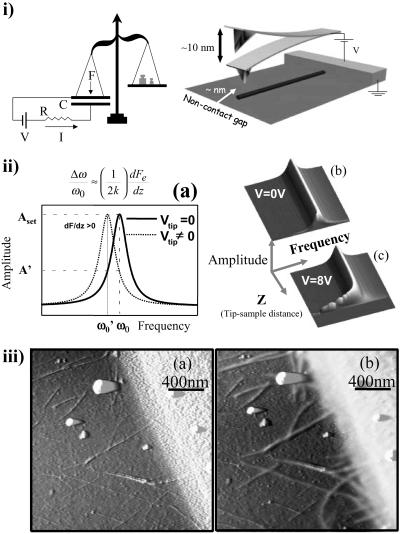Figure 1.
The nonintrusive method used in this work is illustrated. (i) The MW, characterized by a resistance (R) and a capacitance (C), is connected to a metal electrode. A SFM metallic tip of force constant k is placed over the molecule. The tip is oscillated at its resonance frequency ω0, and the amplitude of the oscillation is monitored and kept constant. When a voltage V is applied between the tip and the sample the molecule gets charged, and an attractive force appears between the tip and the sample. The RC factor of the MW determines the time required for the molecule to be charged. The experiment can be seen as a balance (force sensor), a battery, a resistor R, and a capacitance C. When the circuit is closed, electrical charges are accumulated at the plates, giving rise to an electrostatic force that is detected by the balance. The gradient of the electrostatic force introduces a shift of the resonance frequency to lower values. (iia) This frequency shift is shown. (iib) The oscillation amplitude A is measured as a function of the frequency ω and the tip-sample distance z A(ω,z), since no voltage is applied between the tip and metallic sample, no frequency shift caused by long-range interaction is observed. (iic) A bias voltage of 8 V is applied, producing a clear frequency shift. The total z displacement in these images is 200 nm. (iiia) SFM topography showing randomly dispersed SWNT on a silicon oxide substrate where some of the molecules appear partially covered by a gold electrode. (iiib) SFM topography showing the same area as in iiia but with a tip-sample bias voltage of +2 V. Notice that those SWNTs electrically connected to the metal electrode appear wider and higher because of the electrostatic interaction.

